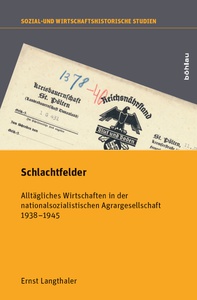RHN 11/2016 | Publication
Ernst Langthaler, Schlachtfelder. Alltägliches Wirtschaften in der nationalsozialistischen Agrargesellschaft 1938–1945 (Sozial- und wirtschaftshistorische Studien 38), Böhlau: Wien 2016.
An Open-Access version of the book is now available online (PDF)!
Previous research on agrarian society in Nazi Germany has focused either on the regime’s actions or the rural population’s reactions. In order to overcome this opposition, this study concentrates on the fields of interaction between Nazi regime and rural population.
Taking the province of Niederdonau in German-annexed Austria as an example, the study aims at answering the following questions: first, how did the actors use resources such as land, labour, capital, knowledge and products in their farming practice? Second, which power relations did the actors establish among themselves and with the instances of the political-economic system? Third, how were life-world, state and market regulation of farming related to each other?
The investigation builds upon a diverse resource base, consisting of ego-, official and published documents, which is being interpreted with aid of qualitative and quantitative methods. The results correct and extend the current state of research on Austrian agrarian society in the Nazi era. Contrary to the conventional wisdom of the Nazi era as an interlude or step backwards on the way to modernity, the study outlines the contours of a Nazi megaproject directed towards an alternative modernity beyond liberalism and socialism: on the one hand, the peasantry as a backbone of the ‘people’s body’ (Volkskörper) should be strengthened; on the other hand, farm productivity should be raised according to national autarky. The megaproject of racial productivism – the creation of a both ‘racially’ and technically productive peasant – became effective at different levels of the agrosystem: At the technical level, only state-supported pioneer farms managed to raise land use intensity; the overwhelming majority tended to extensification due to lack of labourers and equipment. At the institutional level, the nation state was established as the central regulator of the agricultural sector – from factor- and product markets to the actors’ habitus. Though agrarian modernization was intended by the Nazi decision-makers, it became only partially effective. Despite the Nazi regime’s attempts, a ‘green revolution’ in the full – both technical and institutional – sense did not take place in German-annexed Austria. However, the years 1938 to 1945 were a kind of ‘pre-revolutionary’ transitional period, which passed on stable institutions for the technical take off of the agricultural revolution in postwar Austria. Though the ‘great leap’ to racial productivism failed, the actors of the agrosystem took small steps along the productivist transition between the 1930s and 1950s.
